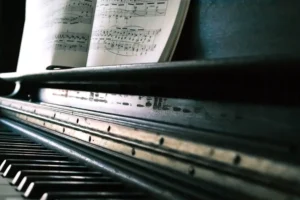The Phrygian mode offers a distinctive, exotic sound with its minor scale feel and lowered second degree. It evokes the mystique of Middle Eastern melodies and the fiery passion of Spanish flamenco, making it a versatile tool for expanding your piano repertoire and deepening your music theory knowledge.
What is the Phrygian mode? In this guide, we’ll explore the unique qualities of the Phrygian mode, how it differs from other modes, and practical steps to incorporate it into your playing, complete with charts and tips to support your practice.
- Fall in love with the music - Learn your favorite songs, at a level suitable for you.
- Enjoy interactive piano lessons - Explore courses covering music theory, technique chords & more.
- Get real-time feedback - Skoove's feedback tells you what went well and what needs practice.

What is the Phrygian mode?
The Phrygian mode is one of seven musical modes found in a major scale. It is derived from the major scale but features a distinctive lowered second note that gives it an exotic and mysterious quality. The Phrygian mode has roots in ancient Greek music, where modes were associated with different emotional states. In medieval Europe, it was often used in sacred music to evoke introspection and reverence. Over time, the Phrygian mode found its way into flamenco, classical and even contemporary music genres like metal and jazz.
A Phrigian scale is defined by its interval pattern:
H-W-W-W-H-W-W
(H = Half Step, W = Whole Step)
This pattern gives the Phrygian mode its minor scale feel; it can be thought of as the Phrygian mode formula, with the added twist of a lowered second note that creates its mysterious sound.
For example, if you start the Phrygian mode on E, the notes are:
E-F-G-A-B-C-D-E

Here’s what makes the Phrygian mode unique:
- The minor third gives it a minor scale quality.
- The lowered second note creates a distinctive, exotic flavor.
Compare this to the natural minor scale (E-F#-G-A-B-C-D-E), and you’ll notice the F in the Phrygian mode is flattened, giving it that characteristic tension.
 Phrygian mode scales
Phrygian mode scales
Built on the third degree of the major scale, the Phrygian mode is defined by its interval pattern:
To understand the Phrygian mode, it’s essential to see how it transforms across different keys. Whether you’re playing in C, E, or F♯ Phrygian, the mode’s unique interval structure remains constant.
Below is a comprehensive table showing the Phrygian modes across all 12 keys:
| Mode | Notes |
|---|---|
| C | C – D♭ – E♭ – F – G – A♭ – B♭ – C |
| C♯/D♭ | C♯ – D – E – F♯ – G♯ – A – B – C♯ |
| D | D – E♭ – F – G – A – B♭ – C – D |
| D♯/E♭ | E♭ – F♭ – G♭ – A♭ – B♭ – C♭ – D♭ – E♭ |
| E | E – F – G – A – B – C – D – E |
| F | F – G♭ – A♭ – B♭ – C – D♭ – E♭ – F |
| F♯/G♭ | F♯ – G – A – B – C♯ – D – E – F♯ |
| G | G – A♭ – B♭ – C – D – E♭ – F – G |
| G♯/A♭ | A♭ – B♭♭ – C♭ – D♭ – E♭ – F♭ – G♭ – A♭ |
| A | A – B♭ – C – D – E – F – G – A |
| A♯/B♭ | B♭ – C♭ – D♭ – E♭ – F – G♭ – A♭ – B♭ |
| B | B – C – D – E – F♯ – G – A – B |
The Phrygian mode and scale degrees
Diatonic modes of the major scale, such as Phrygian, can be formed by playing a major scale from a specific degree. The Phrygian mode is formed by playing from the third degree. Let’s break this down:
1. Start with a major scale: For example, in C major (C Ionian), the notes are: C, D, E, F, G, A, B, C.
2. Begin on the third note: Start on E instead of C.
3. Play the same sequence of notes as the major scale starting on the third degree:E, F, G, A, B, C, D, E.
Now you have constructed the E Phrygian mode from the third degree of a major scale. Well done!
This process works for any key. Try forming some more examples of the Phrygian scale and check them against the table we just looked at.
How to play the Phrygian mode on piano?
As with any of the piano scales you may have practiced, mastering the Phrygian mode on the piano unlocks a world of creative potential. Its distinctive minor feel with a lowered second gives it an exotic, mysterious sound, making it ideal for crafting evocative melodies and engaging improvisations.
Start with E Phrygian:
- Place your right-hand thumb (finger 1) on E.
- Use this finger pattern: 1 (E), 2 (F), 3 (G), thumb under to 1 (A), 2 (B), 3 (C), 4 (D), 5 (E).
- Descend back using the same fingering.
Add the left hand:
- Begin with your pinky (finger 5) on E.
- Follow the pattern: 5 (E), 4 (F), 3 (G), 2 (A), thumb (1) for B, cross over with 3 (C), 2 (D), 1 (E).
- Practice ascending and descending until the motion feels smooth.
Move to other keys:
- Once you’ve mastered E Phrygian try C Phrygian (C, Db, Eb, F, G, Ab, Bb, C) or A Phrygian (A, Bb, C, D, E, F, G, A).
Practice with variations:
- Rhythm: Add syncopation or triplets to make your practice more engaging.
- Dynamics: Play softly (piano) or loudly (forte) to explore expressive contrasts.
- Improvisation: Use the Phrygian mode to create melodies or riffs.
Learning the Phrygian mode can feel overwhelming, especially when exploring all its scales and keys. That’s where Skoove comes in. With interactive piano lessons and real-time feedback, whether you’re mastering scales or looking for how to play piano for beginners, Skoove provides a helping hand on your piano journey.
Top 3 songs to play with Phrygian mode
The Phrygian mode, with its exotic, minor feel and lowered second, offers a unique character in music. Here are three great songs you can learn with Skoove to explore the distinct sound of Phrygian music while enhancing your piano skills!
1. Salt Peanuts – John “Dizzy” Gillespie
This iconic jazz tune is perfect for experimenting with Phrygian melodies through improvisation adding an intriguing flavor to the melody. It’s an excellent example of how the Phrygian mode can be applied to fast-paced, energetic jazz improvisation.
2. Take The A Train – George Kerr
This classic jazz standard provides a rich harmonic foundation, making it a great piece for experimenting with Phrygian melodies through improvisation. Its sophisticated chord changes offer plenty of opportunities to explore the unique characteristics of the Phrygian mode in a vibrant musical context.
3. All the Things You Are – Frank Sinatra
Much like the previous example, this classic tune offers opportunities to explore different modes, including Phrygian. As the song moves through various key changes, it provides a great platform for experimenting with the Phrygian mode in different harmonic contexts.
Conclusion
The Phrygian mode’s exotic sound is perfect for evoking mystery, drama and cultural flavor, making it a favorite in genres from Spanish flamenco to cinematic scores. By practicing the Phrygian mode, you’ll unlock new creative possibilities in your music. Tools like Skoove offer interactive lessons and real-time feedback to make the learning process both educational and enjoyable. Sit at your piano, explore the Phrygian mode and let its unique tones inspire your next masterpiece. Happy practicing!
Author of this blog post:
Susana Pérez Posada

With over seven years of piano education and a deep passion for music therapy, Susana brings a unique blend of expertise to Skoove. A graduate in Music Therapy from SRH Hochschule Heidelberg and an experienced classical pianist from Universidad EAFIT, she infuses her teaching with a holistic approach that transcends traditional piano lessons. Susana’s writings for Skoove combine her rich musical knowledge with engaging storytelling, enriching the learning experience for pianists of all levels. Away from the piano, she loves exploring new places and immersing herself in a good book, believing these diverse experiences enhance her creative teaching style.
Published by Lydia Ogn from the Skoove team














